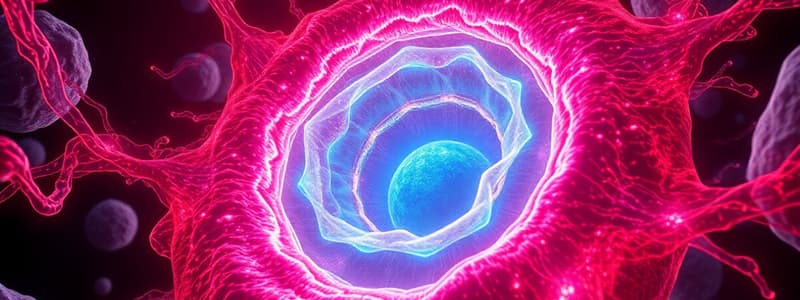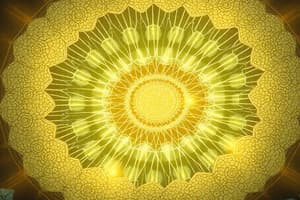Podcast
Questions and Answers
What is the main function of the nuclear pores?
What is the main function of the nuclear pores?
- Synthesize proteins
- Generate energy for cellular processes
- Allow import/export of molecules in and out of the nucleus (correct)
- Store genetic information
Which component of the nucleus contains DNA?
Which component of the nucleus contains DNA?
- Nucleolus
- Nuclear pores
- Nuclear envelope
- Chromatin (correct)
What is the structural composition of the outer membrane of the nuclear envelope?
What is the structural composition of the outer membrane of the nuclear envelope?
- Aqueous solution of nucleotides
- Phospholipid bilayer containing phosphate groups and cholesterol (correct)
- Single lipid layer with protein channels
- Fibrous proteins and DNA
What role does the inner membrane of the nucleus play?
What role does the inner membrane of the nucleus play?
How is the nuclear envelope connected to the Rough Endoplasmic Reticulum?
How is the nuclear envelope connected to the Rough Endoplasmic Reticulum?
Which type of RNA is primarily synthesized in the nucleolus?
Which type of RNA is primarily synthesized in the nucleolus?
Which structure is responsible for ribosome assembly within the nucleus?
Which structure is responsible for ribosome assembly within the nucleus?
What effect does the methylation of histone proteins typically have on DNA structure?
What effect does the methylation of histone proteins typically have on DNA structure?
Which structure is continuous with the rough endoplasmic reticulum (RER)?
Which structure is continuous with the rough endoplasmic reticulum (RER)?
What type of molecules primarily utilize the nuclear pores for transport?
What type of molecules primarily utilize the nuclear pores for transport?
Which process directly involves the assembly of ribosomes?
Which process directly involves the assembly of ribosomes?
What defines the lamina layer within the nucleus?
What defines the lamina layer within the nucleus?
Which type of molecule can exit the cell without the need for ATP?
Which type of molecule can exit the cell without the need for ATP?
What process occurs during mitosis involving DNA?
What process occurs during mitosis involving DNA?
What is the effect of histone protein methylation on gene transcription?
What is the effect of histone protein methylation on gene transcription?
What happens to DNA during acetylation of histone proteins?
What happens to DNA during acetylation of histone proteins?
Where are ribosomal RNA and ribosome synthesis predominantly carried out within the cell?
Where are ribosomal RNA and ribosome synthesis predominantly carried out within the cell?
Which function is NOT associated with the nuclear pore complex?
Which function is NOT associated with the nuclear pore complex?
How do small molecules generally enter the nucleus?
How do small molecules generally enter the nucleus?
Which of the following structures is primarily associated with the nuclear membrane?
Which of the following structures is primarily associated with the nuclear membrane?
Which statement is true regarding the nuclear pore and transport mechanisms?
Which statement is true regarding the nuclear pore and transport mechanisms?
What type of chromatin is often associated with inactive genes?
What type of chromatin is often associated with inactive genes?
What is the main role of the nucleolus?
What is the main role of the nucleolus?
What process converts DNA into mRNA?
What process converts DNA into mRNA?
Which structure is primarily responsible for synthesizing proteins?
Which structure is primarily responsible for synthesizing proteins?
How do small molecules typically enter the nucleus?
How do small molecules typically enter the nucleus?
What type of RNA is synthesized from DNA during transcription?
What type of RNA is synthesized from DNA during transcription?
What is the role of the Golgi apparatus in protein synthesis?
What is the role of the Golgi apparatus in protein synthesis?
What process is required to transport large molecules, like RNA, out of the nucleus?
What process is required to transport large molecules, like RNA, out of the nucleus?
How do ribosomal subunits combine with rRNA?
How do ribosomal subunits combine with rRNA?
What structure is continuous with the rough endoplasmic reticulum (RER)?
What structure is continuous with the rough endoplasmic reticulum (RER)?
Which of the following is NOT a function of lamina proteins?
Which of the following is NOT a function of lamina proteins?
What mechanism allows the export of ribosomal subunits from the nucleus?
What mechanism allows the export of ribosomal subunits from the nucleus?
What is the primary function of the nucleolus?
What is the primary function of the nucleolus?
Which molecules are produced during the transcription process?
Which molecules are produced during the transcription process?
How do mRNA and tRNA contribute to protein synthesis?
How do mRNA and tRNA contribute to protein synthesis?
What roles do histone proteins play in the structure of chromatin?
What roles do histone proteins play in the structure of chromatin?
What is the primary function of DNA polymerases in the context of the nucleus?
What is the primary function of DNA polymerases in the context of the nucleus?
What is the structure of the inner membrane of the nucleus known for?
What is the structure of the inner membrane of the nucleus known for?
Where do tRNA molecules go after they are synthesized?
Where do tRNA molecules go after they are synthesized?
Which type of RNA is incorporated within ribosomal subunits?
Which type of RNA is incorporated within ribosomal subunits?
What is a nucleosome?
What is a nucleosome?
Which correct workflow describes the role of RNA in the cell's function?
Which correct workflow describes the role of RNA in the cell's function?
Flashcards are hidden until you start studying
Study Notes
Cell Nucleus Structure
- The nuclear envelope is a double-layered phospholipid bilayer, containing an outer and an inner membrane.
- The outer membrane is continuous with the rough endoplasmic reticulum (RER).
- The outer membrane contains phosphate groups, fatty acid tails, and cholesterol.
- The inner membrane contains a lamina layer composed of lamins, proteins that play a role in DNA replication, transcription, and organization.
- The nuclear envelope is perforated by nuclear pores, made of integral transmembrane proteins.
- These pores are responsible for importing and exporting molecules in and out of the nucleus.
- The size of the molecule determines whether the nuclear pore is used for import or export.
- The nuclear contents include chromatin and the nucleolus.
- Chromatin consists of DNA and histone proteins.
- DNA is a negatively charged double helix molecule; DNA replication and transcription are mediated by DNA polymerase.
- Histone proteins are positively charged and form an octamer that interacts with the negatively charged DNA, facilitating DNA packaging.
- The nucleolus is the site of ribosomal RNA (rRNA) and ribosomal synthesis.
- rRNA is incorporated into ribosomal subunits.
- tRNA and mRNA are produced from DNA and exit the nucleus via nuclear pores.
- mRNA binds with ribosomes, both free and bound to RER.
- tRNA carries an amino acid to the ribosomes.
- rRNA, tRNA, and mRNA are involved in reading mRNA to produce proteins.
- Chromatin consists of DNA and histone proteins.
Nucleus Function
- The nuclear envelope functions to regulate the transport of molecules between the nucleus and the cytoplasm.
- The inner membrane contains the lamina layer, which plays a role in DNA replication, transcription, and organization.
- Nuclear pores are responsible for the import and export of molecules in and out of the nucleus.
- Small molecules can enter the nucleus passively, while large molecules are transported out of the nucleus actively using ATP.
- Chromatin is made up of DNA and histone proteins.
- Histones function to package DNA into nucleosomes.
- Histone methylation leads to DNA condensation, known as heterochromatin, inhibiting transcription.
- Histone acetylation causes DNA to loosen up, becoming euchromatin, which allows transcription to take place.
- The nucleolus is responsible for rRNA and ribosomal synthesis.
- rRNA is incorporated into ribosomal subunits inside the nucleolus, forming ribosomes.
- Ribosomes either become free in the cytosol or bind to the RER.
- ribosomes work together to synthesize proteins.
Review Questions
- Lamin proteins are found in the inner membrane layer of the nuclear envelope.
- Small molecules can enter the nucleus through a passive process, while large molecules can exit the nucleus through an active process that uses ATP.
- The outer membrane of the nuclear envelope is continuous with the RER
- Methylation of histone proteins leads to a condensed form of DNA called heterochromatin.
- The nucleolus is the site of ribosomal synthesis.
- rRNA is incorporated into ribosomal subunits.
Studying That Suits You
Use AI to generate personalized quizzes and flashcards to suit your learning preferences.



